How to read signage at German train stations
You’re excited – you’ve finally arrived in Germany. You’ve decided to travel the country by train, but you’re not familiar with the German language, and you may find the signs puzzling and difficult to read.
The following is a short guide to signage at German train stations to help get you on your way. Examples below are taken from Frankfurt am Main Hauptbahnhof (central or main train station), although descriptions should apply similarly at other stations.
Below are descriptions for:
- Departures board (Abfahrtstafel)
- Destination signage (Zugzielanzeiger)
- Car sequence signage (Wagenreihungsplan)
- Arrivals-, departures schedules (Ankunfts-, Abfahrtspläne)
Departures board (Abfahrtstafel)
Where is my train?
In most medium- to large-sized German cities, every Hauptbahnhof (Hbf) or central train station will have a large departures board in the central hall and/or over the information booth. The photo above shows the departures board in the middle of Frankfurt’s station with the message:
“Herzlich Willkommen in Frankfurt am Main Hbf – Welcome to Frankfurt am Main Central Station”.
Information on the departures board appears as white block lettering on a dark blue background. From left to right in the photo below, there are six primary columns of information:
- Departure time (Zeit)
- Train number
- Intermediate stops (Über)
- Final destination for train (Ziel)
- Track or platform (Gleis)
- Additional information
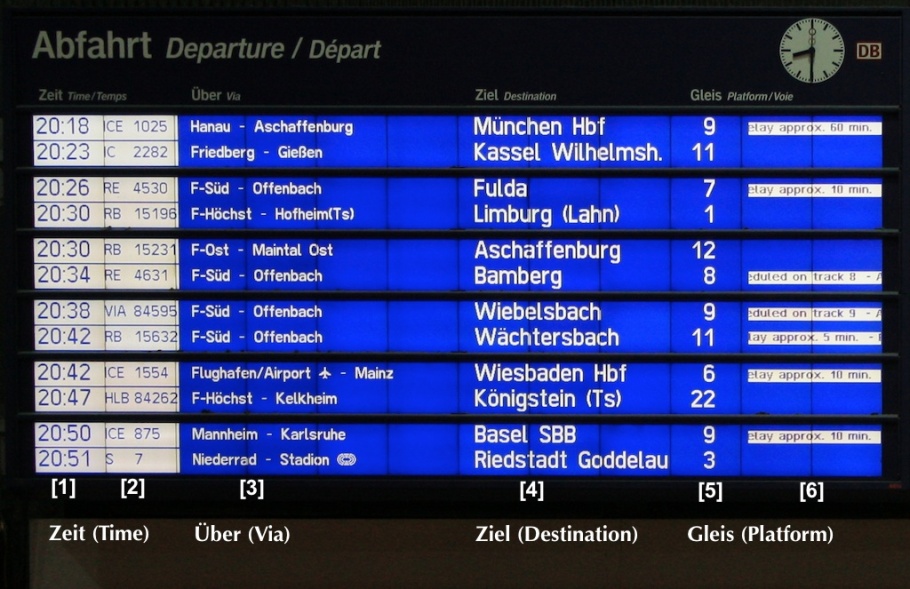
The departures board above shows Regional Bahn train RB 15231 leaving at 830pm (2030h) for Aschaffenburg from platform 12, with stops at F-Ost (Frankfurt Ost) and Maintal Ost. There’s no additional information which means the train is scheduled to depart on time.
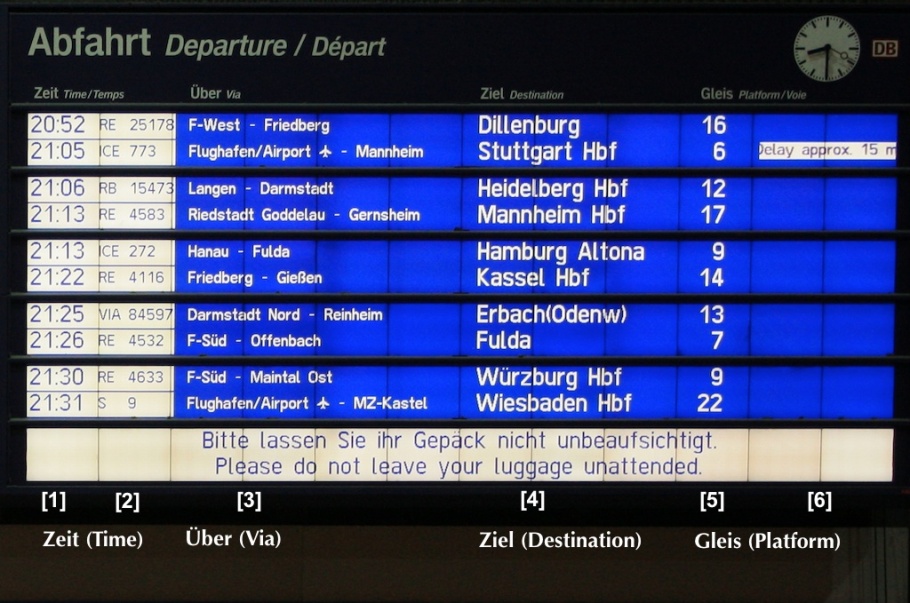
The other departures board shows InterCity Express ICE 773 leaving for Stuttgart from platform 6 at 905pm (2105h), with stops at Frankfurt Airport (Flughafen) and the city of Mannheim. There’s an additional note that the train is about 15 minutes late, putting the departure time to about 920pm.
Destination signage (Zugzielanzeiger)
What is my train, by day
Above every platform are overhead digital signs to confirm what travelers might see on the central board. The signs also appear as white lettering on a blue background. Occasionally, two trains will share the same platform which the signage will also reflect. Highlighted sections will correspond to the appropriate train; take note that you board the correct train.
The following are examples of daytime departures from platforms 8 and 9, at Frankfurt central station.


From platform 8, InterCity Express train ICE 76 leaves at 1158am for Kiel Hauptbahnhof (Hbf), with stops in Kassel-Wilhelmshöhe, Göttingen, Hannover, and Hamburg Hauptbahnhof. There’s a five-minute delay, pushing the departure time to about 1203pm.
Every platform is “divided” into sections, which are also labeled with overhead signage (A, B, C, etc.) indicating where you are along the platform. The electronic sign also shows how the train itself is divided. 1st-class cars are in section A, the dining car is in section B, and the rest of the train consists of 2nd-class cars from sections C through E.
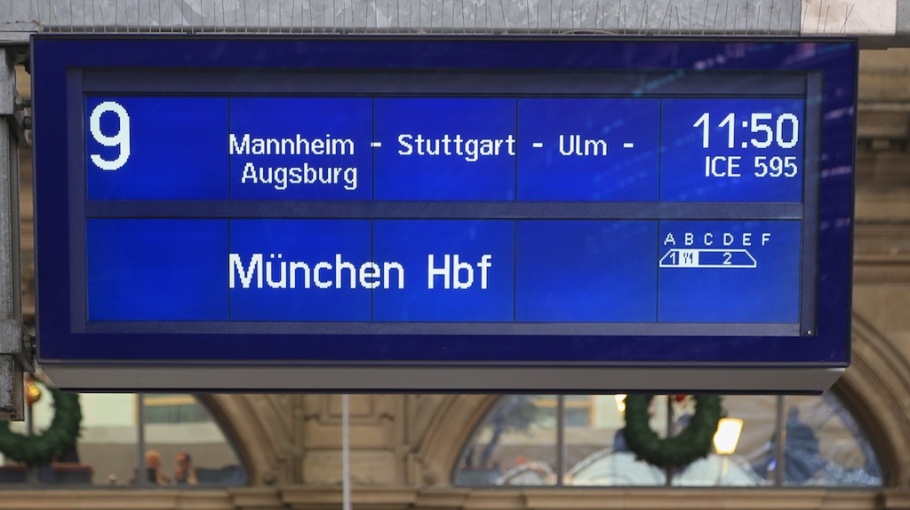
From platform 9, InterCity Express train ICE 595 leaves at 1150am for München (Munich) Hauptbahnhof, with stops in Mannheim, Stuttgart, Ulm, and Augsburg. The sign above shows that first-class cars are along section A, the dining car along section B, and the rest of the train consists of second-class cars from sections C through E.
What is my train, at night
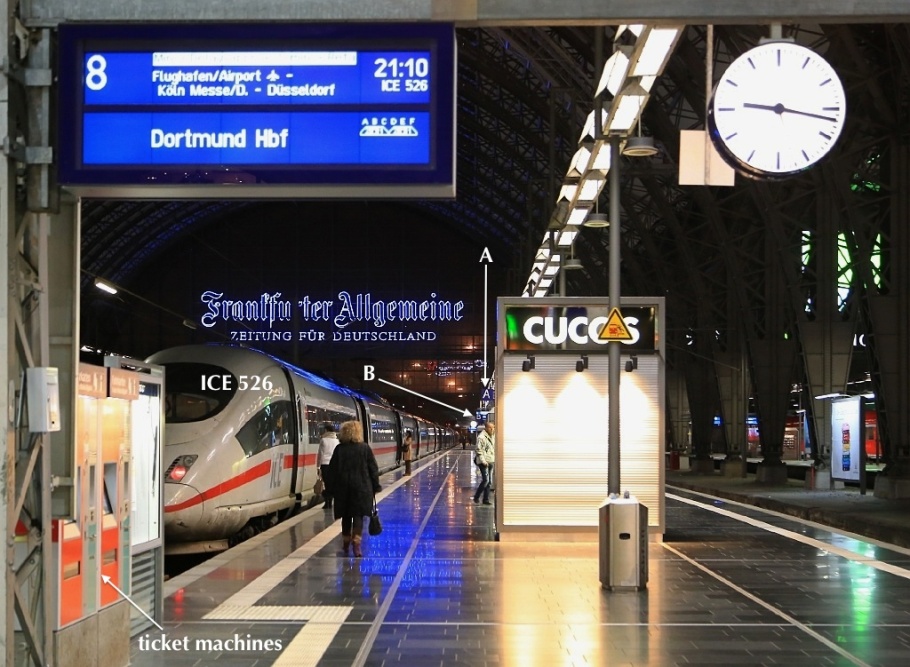
It’s 917pm, but the 910pm train from platform 8 hasn’t departed. I’ve labeled the train ICE 526, overhead signage indicating platform sections ‘A’ and ‘B’, as well as the familiar red and blue Deutsche Bahn ticket machines. It’s preferable (and often cheaper) to purchase a ticket before boarding the train; the ticket machines have multilingual options and sell tickets for regional and long-distance trains.
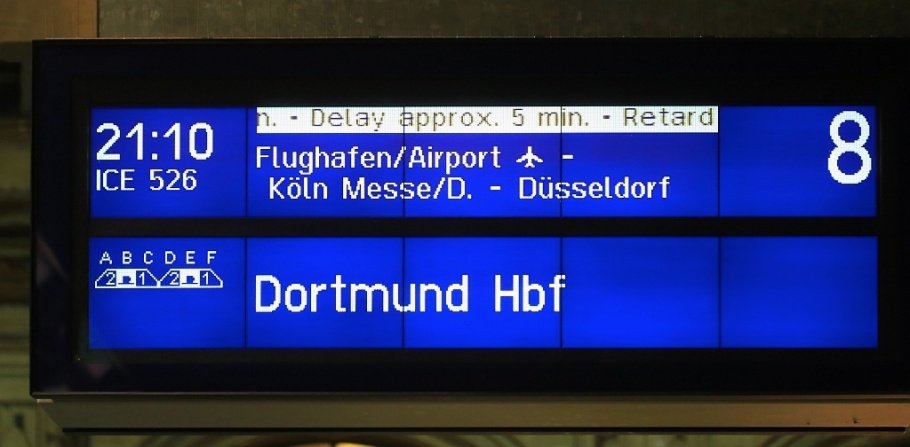
In fact, ICE 526 heading to Dortmund Hauptbahnhof is approximately 5 minutes late, which means this train is about to leave at any moment. The train makes stops at Flughafen Frankfurt am Main Airport and in Köln (Cologne) at Messe/Deutz station. Note that 2nd-class cars are located along sections A and D, dining cars at sections B and E, and 1st-class cars at sections C and F.
“Multizuganzeige” signage
Some of the latest installed information signage includes multiple trains: the current train at the track, and the next two trains to appear at the same track.
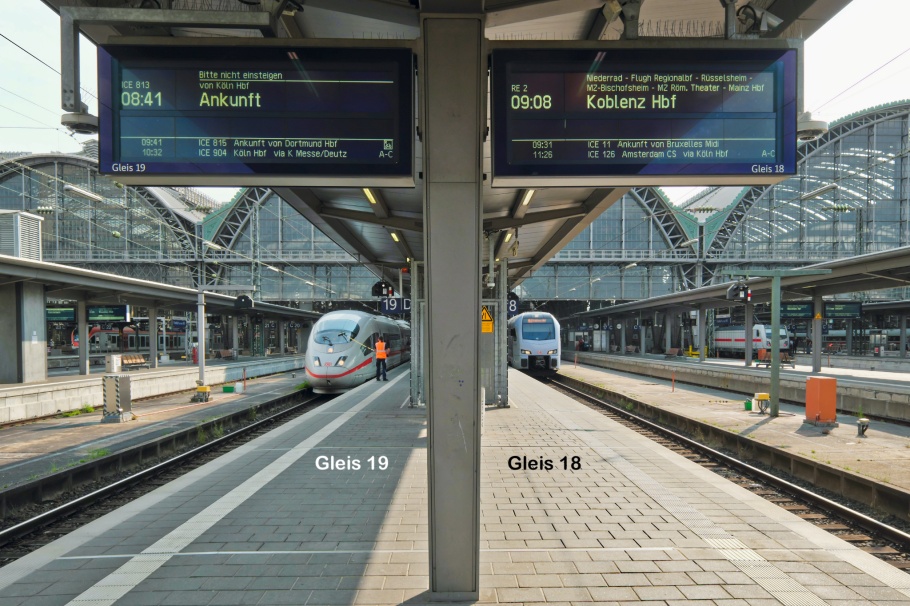
Frankfurt am Main Hauptbahnhof, tracks 18 and 19. Photo, 19 Jun 2023 (X70).
Seen here above tracks 19 (left) and 18 (right) are the most recent version of destination signage installed at regular intervals along the platforms.

F-Hbf track 18 destination display, as simulated on ZuDis.
On track 18, train RE 2 will depart at 908am for Koblenz central station with stops at Frankfurt airport’s regional train station (Flugh Regionalbf), Mainz’s Roman theater (MZ Röm. Theater), and Mainz central station (Mainz Hbf). The next two trains to appear at track 18 are: ICE 11 arriving from Brussels Midi at 931am, and ICE 126 departure scheduled at 1126am for Amsterdam central station (Amsterdam CS) via Cologne central station (Köln Hbf) along track sections A through C inclusive.
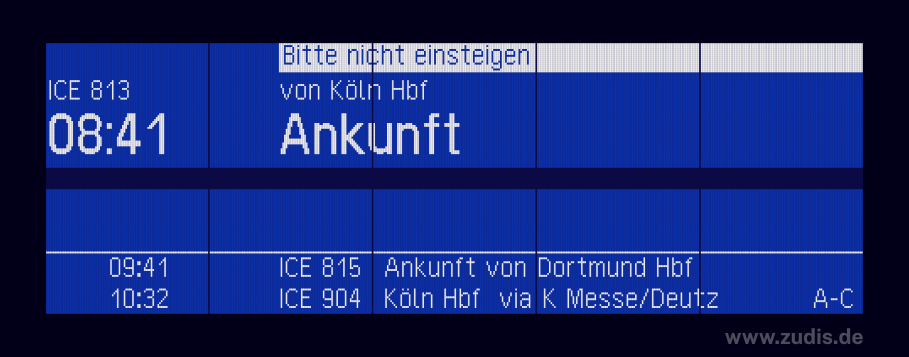
F-Hbf track 19 destination display, as simulated on ZuDis.
On track 19, train ICE 813 arrived (Ankunft) from Cologne central station at 841am with instructions not to board the train (Bitte nicht einsteigen). The next two trains to appear at track 19 are: ICE 815 arriving from Dortmund at 941am, and ICE 904 departure scheduled at 1032am for Cologne central station via Cologne Messe/Deutz along track sections A through C inclusive.
Car sequence signage (Wagenreihungsplan)
Where is my coach or car?
If you’ve purchased a ticket with assigned seating in a specific coach or car, you have to locate the correct coach for the train. Every station platform has a large sign “Wagenreihungsplan” or “Wagenstandsanzeiger”, describing how coaches are sequenced for each train leaving from that platform.
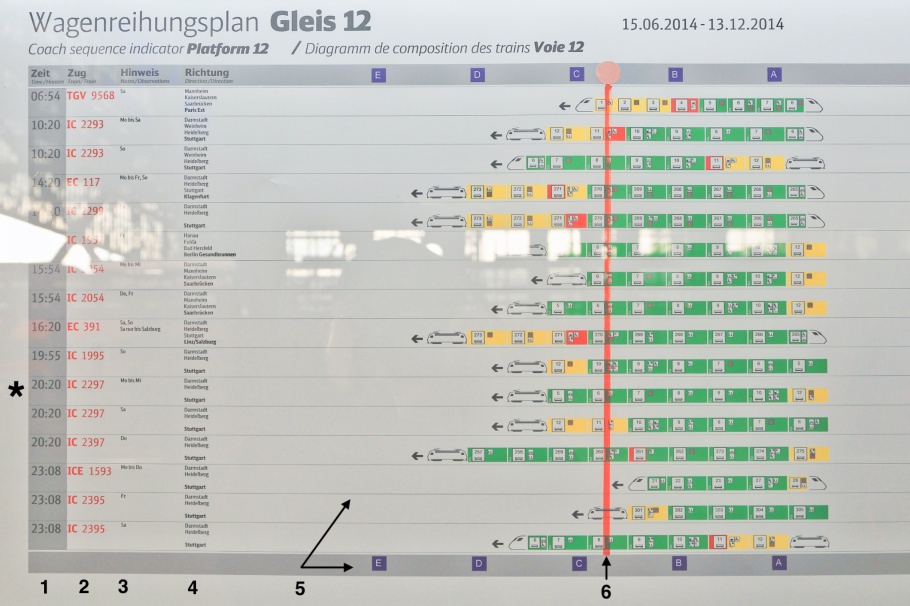
Wagenreihungplan (car sequence) for trains on track 12, Frankfurt am Main Hauptbahnhof.
The photo above are for trains departing Frankfurt train station from track 12, effective for the period in 2014 between June 15th and December 13th (15.06.2014 – 13.12.2014). Shown left to right are the labeled columns:
- Departure time (Zeit)
- Train (Zug)
- Information, notes (Hinweis)
- Direction, destination (Richtung, Ziel)
- Coach sequence (Wagenreihung)
- Signage location, “where am I?” (Standort)
Coaches in green are 2nd-class cars, coaches in yellow are 1st-class cars, and coaches in red are dining cars. Every coach is labeled by a number. The short black arrow next to the train’s locomotive engine indicates the direction of the train leaving the station. In the sign shown above, coaches next to platform sections C, D, E are at the “front” of the departing train at Frankfurt station.
But where am I; where is the location of this “Wagenreihungsplan” signage? The answer is given by the red dot and red vertical line; they indicate I’m standing between platform sections B and C.
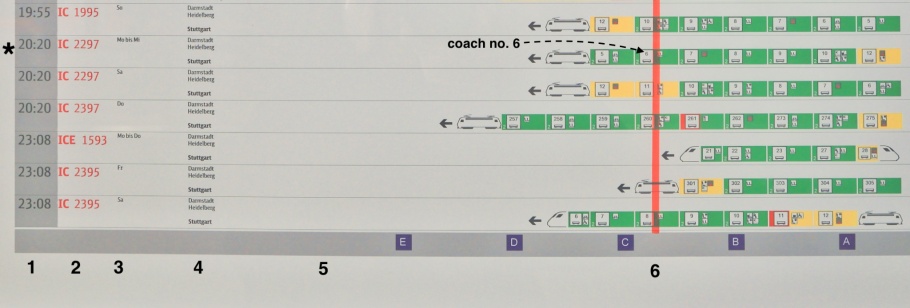
Track 12: IC2297 coach sequence for departures Mo-Mi (Monday to Wednesday), Do (Thursday), Sa (Saturday).
Train IC2297 leaves platform 12 at 820pm (2020h) for Stuttgart. However, there are three rows for the same train number, indicating different coach sequences for different days of the week. The train indicated by the black asterisk is assigned for departures Monday to Wednesday (Montag bis Mittwoch) inclusive. Where the red vertical line intersects this row shows that the “Wagenreihungsplan” signage is located opposite 2nd-class coach number 6. The coach sequence is different for Thursday (Do) and Saturday (Sa) departures.
At times, you may hear a public announcement and/or see a notice on the overhead track signage about changes to the coach sequence: namely,
• umgekehrte Wagenreihung: coach sequence is completely reversed.
• abweichende Wagenreihung: coach sequence is different than scheduled.
Schedules (Pläne)

Car sequence information, arrivals schedule: Frankfurt am Main Hauptbahnhof.
You’ll also see printed-paper displays for arrivals and departures. Arrivals schedules (Ankunftspläne) are displayed as black text on a white background, and departures schedules (Abfahrtspläne) are displayed as black text on a yellow background. The lists of arriving and departing trains are ordered by the time of day.
The two example images below provide information for trains departing Frankfurt train station at 8am and trains arriving at Frankfurt train station at 12pm. The current time in Germany is shown as “aktuelle Uhrzeit“.

8am departures information (in yellow), Frankfurt am Main Hauptbahnhof.
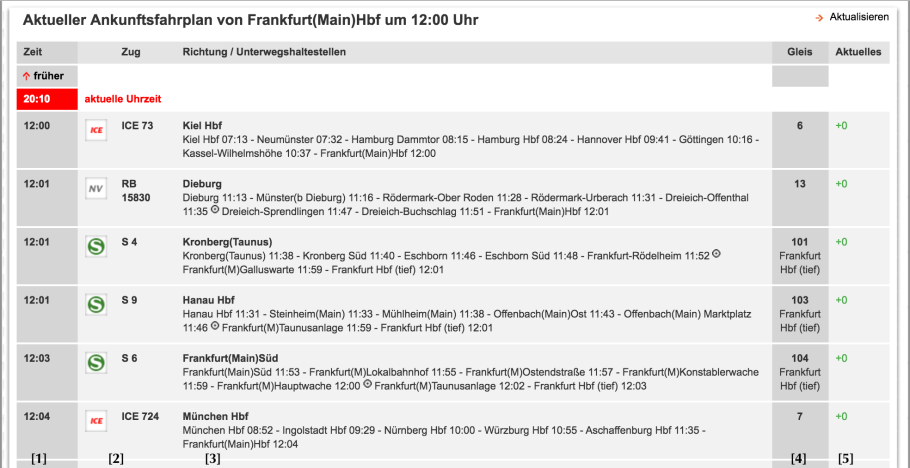
12pm arrivals schedule (in white), Frankfurt am Main Hauptbahnhof
Shown left to right are the labeled columns:
- Time of departure (Abfahrtszeit) OR time of arrival (Ankunftszeit)
- Train (Zug)
- Direction, stops along the way (Richtung, Unterwegshaltestellen)
- Track number (Gleis)
- Real-time information (Aktuelles): numbers in green, on-time/early; numbers in red, late (in minutes)
Departures examples from above:
at 801am, train EC207 will depart on time for Zürich from track 2. The train is scheduled to arrive at Basel central train station (Basel SBB) at 1054am and end in Zürich at 12pm. At 804am, regional S-Bahn trains will depart on time: S6 to Friedberg from track 104 and S1 to Rödermark from track 102. Both S-Bahn trains leave from “Frankfurt Hbf, tief” which is the lower or underground levels of the train station.
Arrivals examples from above:
at 12pm, train ICE73 arrives on track 6 from Kiel (via Hamburg and Hannover). At 1204pm, train ICE724 arrives on track 7 from München (via Nürnberg and Würzburg).
The Deutsche Bahn website also provides an updated to-the-minute online version of an arrivals and departures board here in German or here in English. Up-to-date information is given two hours in advance from your present time, including information about the assigned platform for arriving/departing trains and whether trains are early or late. Just like the printed-paper displays, arrivals and departures are shown on light-grey and yellow backgrounds, respectively.
I made the photos above at Frankfurt am Main Hauptbahnhof on 10 Oct 2009 (450D), 20 Nov 2014 (6D1), and 19 Jun 2023 (X70). This post appears on Fotoeins Fotografie at fotoeins DOT com as http://wp.me/p1BIdT-6k7.
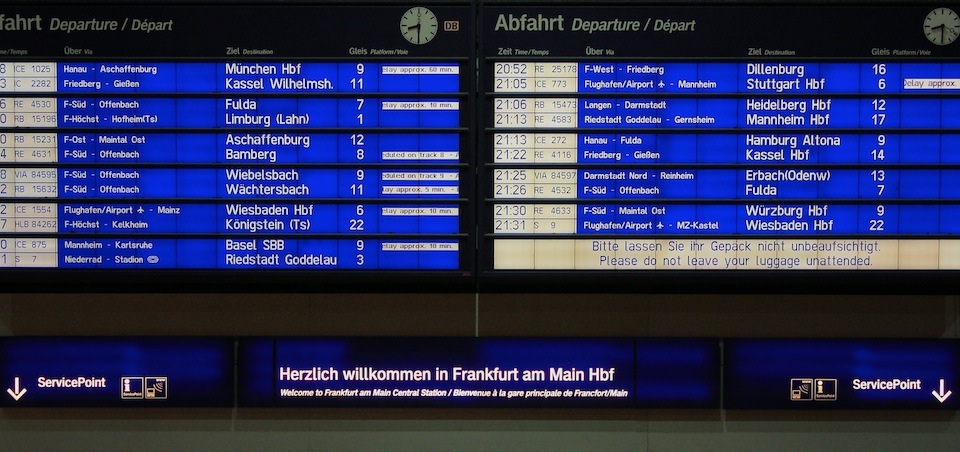
5 Responses to “How to read signage at German train stations”
Those things are just impossible…the worst is when the train departments are in the wrong order so you have to sprint to get into the righting or wait till the next train station to switch. Another bad thing is when you finaly arrive at the right train just to see that they have changed them without the announcement and and and…but I guess this is what happens in every country 🙂
LikeLiked by 1 person
Hi, Timo. Ah yes, the infamous “umgekehrte” or “abweichende” Wagenreihung! This reminder meant I just put an extra section above to describe briefly the Wagenstandanzeiger (Wagenreihungsplan). 😉 Thanks for reading and for your comment!
LikeLiked by 1 person
[…] • How to read signage at German train stations […]
LikeLiked by 1 person
[…] Departures board at the main train station: Frankfurt am Main, Germany – 10 Oct 2009 (450D). […]
LikeLike
[…] service: ICE 5 from Frankfurt am Main to Basel; how to read this signage – 20 May 2016 […]
LikeLike